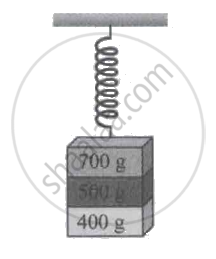Advertisements
Advertisements
प्रश्न
A needle of a sewing machine moves along a path of amplitude 4 cm with a frequency of 5 Hz. Find its acceleration `(1/30)` s after it has crossed the mean position.
उत्तर
Data: A = 4 cm, n = 5 Hz, t = `(1/30)` s, a = - ω2 x, |a| = ω2x
as x = A sin ω t
∴ |a| = ω2 A sin ω t
`= (2 π " n")^2 "A" sin (2 π " n") xx 1/30`
`= 4 pi^2 "n"^2 " A" sin (2 pi 5) 1/30`
`= 4pi^2 xx 25 xx 4 sin (10 pi)/30`
`= 100 pi^2 xx 4 sin pi/3`
`= 100pi^2 xx cancel(4)^2 xx sqrt3/cancel(2)_1`
`= 100 pi^2 xx 2 xx 1.732`
`= 100 xx pi^2 xx 3.464`
`= 346.4 xx 9.87`
= 3420 cm/s2
= 3420 × 10-2 m/s2
|a| = 34.2 m/s2
APPEARS IN
संबंधित प्रश्न
Potential energy of a particle performing linear S.H.M. is 0.1 π2x2 joule. If the mass of the particle is 20 g, find the frequency of S.H.M.
At what distance from the mean position is the kinetic energy of a particle performing S.H.M. of amplitude 8 cm, three times its potential energy?
Two S.H.M.’s have zero phase difference and equal amplitudes A. The resultant amplitude on their composition will be ______
A simple pendulum moves from one end to the other in ¼ second. What is its frequency?
The acceleration due to gravity on the surface of the moon is 1.7 m/s2. What is the time period of a simple pendulum on the surface of the moon if its time period on the surface of the earth is 3.5 s? (g on the surface of earth = 9.8 m/s2)
Obtain an expression for the resultant amplitude of, the composition of two S.H.M.’s having the same period along the same path.
In amplitude modulation,
The total energy of the body executing S.H.M. is E. The kinetic energy of the body, when the displacement is half of the amplitude is ______.
When a mass is hung from a light spring, the spring extends by 10 cm. If the mass is pulled down and let go, it executes S.H.M. with a time period (g = 10 m/s2) ____________.
If 'x', 'v' and 'a' denote the displacement, velocity and acceleration of a particle respectively executing SHM of periodic time t, then which one of the following does not change with time?
Three masses 700 g, 500 g, and 400 g are suspended at the end of a spring and are in equilibrium as shown in figure. When the 700 g mass is removed, the system oscillates with a period of 3 seconds; when the 500 g mass is also removed, it will oscillate with a period of ____________.

The equation of S.H.M. of a particle of amplitude 4 cm performing 150 oscillations per minute starting with an initial phase 30° is ____________.
The amplitude of sound is doubled and the frequency is reduced to one fourth. The intensity of sound at the same point will be ____________.
Two trains are moving towards each other with speeds of 20m/s and 15 m/s relative to the ground. The first train sounds a whistle of frequency 600 Hz. The frequency of the whistle heard by a passenger in the second train before the train meets, is ______. (the speed of sound in air is 340 m/s)
A particle performing SHM starts equilibrium position and its time period is 16 seconds. After 2 seconds its velocity is π m/s. Amplitude of oscillation is ______. `(cos 45° = 1/sqrt2)`
A mass m1 connected to a horizontal spring performs SHM with amplitude A. While mass m1 is passing through mean position, another mass m2 is placed on it so that both the masses move together with amplitude A1. The ratio of `"A"_1/"A"` is ______. (m2 < m1)
A sinusoidal wave travelling in the same direction have amplitudes of 3 cm and 4 cm and difference in phase by `pi/2`. The resultant amplitude of the superimposed wave is ______.
A block of mass m, connected to two springs of spring constants k1 and k2 as shown, oscillates on a smooth horizontal surface. What is the effective spring constant of the oscillation?

A particle performs linear SHM with amplitude A and frequency n. Its speed midway between an extreme position and equilibrium position is ______.
